Donna Diamond: Imagined light
 Introduction
Introduction
The chief perquisite of my ART I SEE blog is getting to meet some of the artists I’ve written about. Last year I totally enjoyed meeting George Walker in his hometown of Toronto after blogging about his wordless narratives in wood engravings. (See: http://www.scottponemone.com/george-walker-wordless-novelist/) Then in June I had the great pleasure to meet Donna Diamond, who was the subject of a January 2015 post on her magical linoleum cuts. (See: http://www.scottponemone.com/donna-diamond-imaginingimaging-mortality-dot-by-dot/) When I first proposed meeting Donna in New York, I sought to visit her Bronx studio. But she demured and suggested instead meeting where she printed her linoleum cuts, namely the Robert Blackburn Printmaking Workshop at 323 West 39th Street, 2nd Floor in Manhattan. (Blackburn is a program of the Elizabeth Foundation for the Arts.) This proved fortuitous because I got to meet the person she credits for the success of her Linoleum cut production, Justin Sanz, Blackburn’s workshop manager.
(I should note accomplanying me on this visit to Donna at Blackburn were my husband Michael Frommeyer and George Walker and his wife Michelle. We coordinated a week in New York with the Walkers and enjoyed a number of behind the scenes museum visits and general good fun.)
This post allows me both to share the new works that Donna showed us at Blackburn–ink drawings and petite mezzotints–and to revisit to her linoleum cuts by talking with Justin.
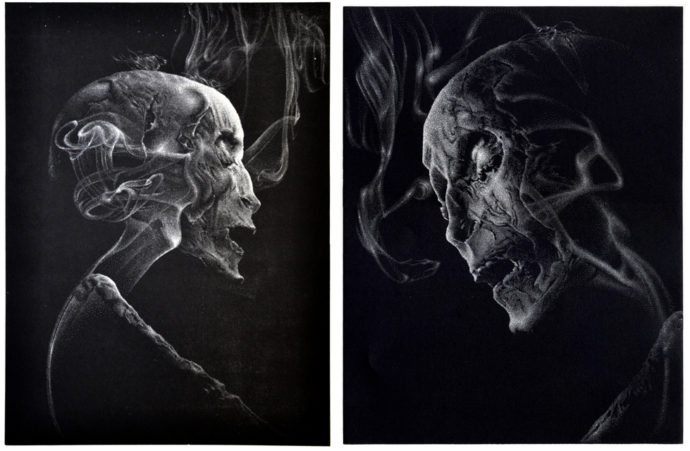
Donna Diamond, Clay and Smoke I, (left), Clay and Smoke II, (right), each linoleum cuts, 22″ x 16″, edition 20
Justin Sanz
Donna is effusive in her praise for Justin Sanz. Without him she knows her Clay and Smoke linocuts would not have been so beautifully printed. During our visit to Blackburn Donna showed us her latest linoleum block–a portrait of her daughter Alex–which hadn’t been editioned yet. Justin didn’t hesitate to examine it as well, knowing that he’ll be called when it was time to print it.
Because he has been so instrumental in printing her linoleum blocks, I decided to get Justin’s perspective on their work together. Via email, we created the following Q&A:
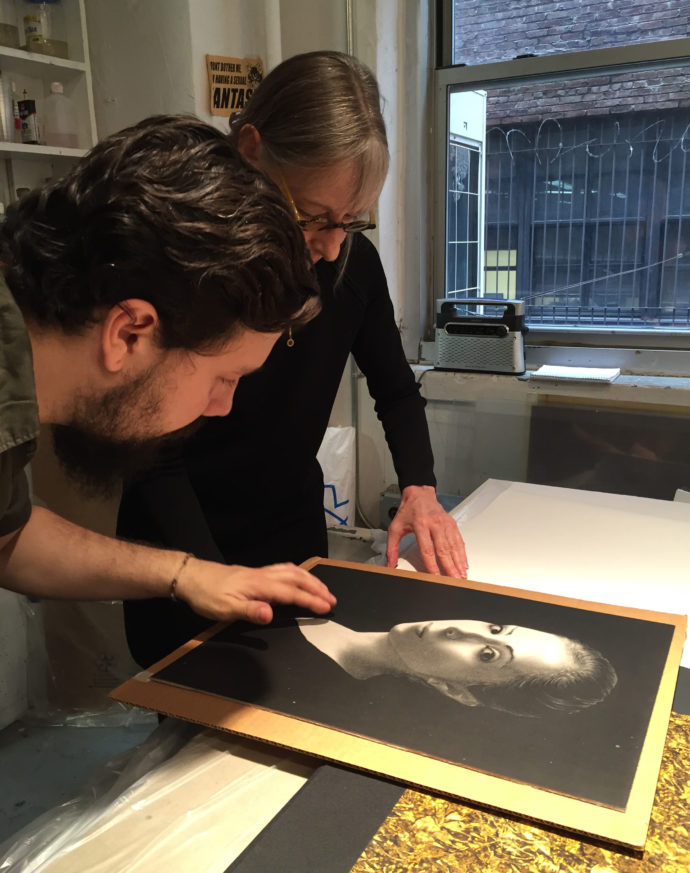
Justin Sanz and Donna Diamond examining her latest linoleum block. (Photo by scott Ponemone)
First off, what is your position at Blackburn, when did that initiate, and what are your duties there?
I am the Workshop Manager at the Blackburn. I have held this position of three of the past five years (a two-year break in between) and have been a part of the workshop since 2005. My duties are very vast and include but are not limited to the following:
Master printer: providing technical expertise to all community members and volunteers, printing and delegating contract print projects, and collaborating with artists to create editions of prints to be sold by the workshop
Educator: developing, organizing and coordinating of printmaking classes and demonstrations; teaching formal classes to members and informally educating 40+ volunteers on printmaking processes
Facilities manager: maintaining the printshop; tracking inventory and stocking Materials; organizing, selecting and providing residencies to eight artists per year; fostering a diverse workshop and continuing Bob Blackburn’s legacy of providing affordable, professional quality printmaking facilities to all.
Gallery director: curating and hanging exhibitions, selling published artwork, and seeking and applying for grants.
When did your first start working with Donna on her linocuts?
I believe it was 2012 or 13.
What type of assistance did she seek from you? What problems had to be solved and how were they solved?
She had done some linocuts and needed them printed. Her cuts are very difficult to print so I had to wet the paper in order to use the most minimal amount of ink possible while achieving large black fields and fine hair line cuts.
How did you manage to get so much detail out of her images?
Practice and 14 years of primarily relief printing. Finding just the right balance of ink to maintain detail and print a dense black. Attentiveness to amount of ink being applied and ability to reproduce the same results through an edition.
In what way was this a collaborative effort?
Donna was unsure of the translation of carving to the way it would print. I showed her what was possible to print. We achieved her desired printed results through careful back and forth of me proofing the plate, adjusting ink levels, and Donna re-carving which sometimes had months in between [printing sessions] for a single image.
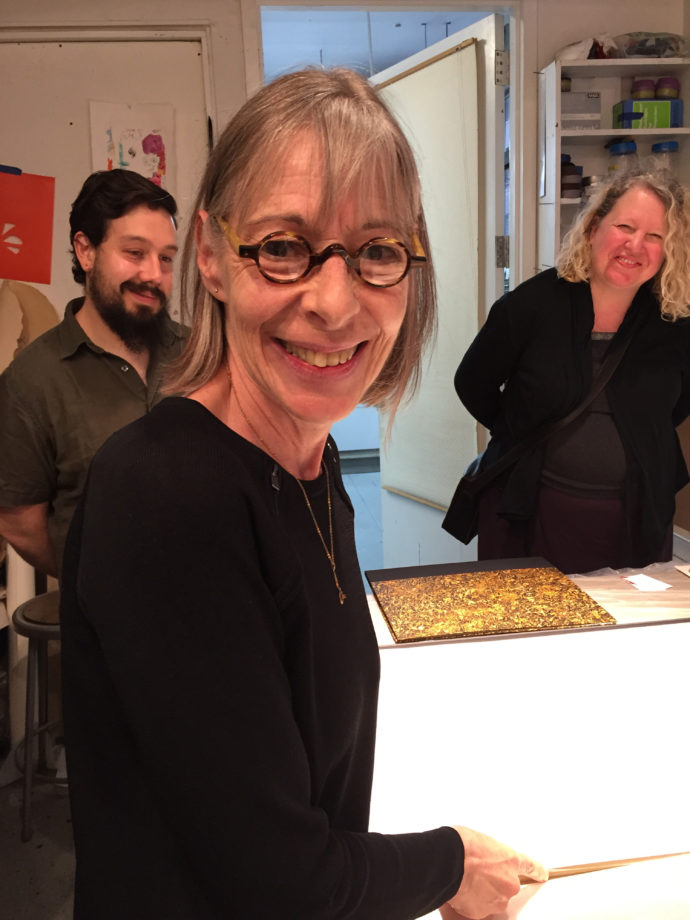
Donna Diamond with Justin Sanz and Michelle Walker . (Photo by Scott Ponemone)
Donna Diamond
After showing us the linoleum block of Alex, Donna completely surprised me. Her newest work was not the delicate realist image of Alex nor the magical realism of the Clay and Smoke prints. But pure investigations of light. First she presented brushed-on ink drawings as large as 28″ x 20″ and then showed five tiny mezzotints, three 2″ x 3″ and two 4″ x 3″. Yet as different as her latest work from the linoleum prints I was familiar with, all of her work exhibited strong contrasts and a fascination with light. This focus on light became the subject of the first questions I posed to her via email.
Mezzotint, I should say, is an intaglio printmaking process in which a metal plate, usually copper, is first given a uniform roughened surface, which if printed would yield a velvety black. The image is then created by burnishing (smoothing out) parts of the plate to various degrees, with the completely burnished areas printing paper white. Of the YouTube videos I scanned perhaps this one, while chatty, by David Crown is the clearest on mezzotints: https://www.youtube.com/watch?v=0whYoJ4_CtE
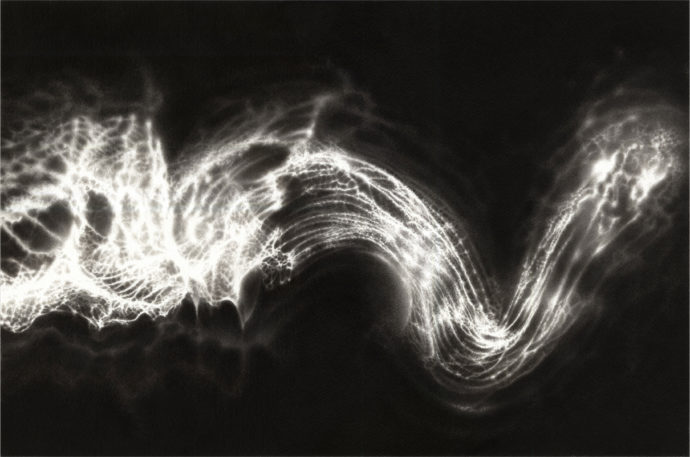
Donna Diamond, Unanswered Questions XIV, 2014, brush and black ink on paper, image: 16″ x 24”
What led you to do your light paintings? In what ways does light fascinate you?
The play of light and shadow has fascinated me as long as I can remember. I was classically trained to render forms in space, but from early on what compelled me was light in space.
As a representational artist, I have explored light as an emotive language that can reveal forms or evaporate them. I have worked with light to assemble and organize space or deconstruct it, convey ambiance and character or render emptiness, develop moments of clarity as well as ambiguity.
About three years ago, I was in my studio at daybreak. A ray of early morning sunlight was reflecting off a plastic print protector onto my wall. I began to flex and bend the plastic and discovered I could manipulate the reflections on my wall and virtually draw with reflected sunlight. The sunlight reflections I created on my studio wall were ephemeral and fleeting. Thinking of these reflections as a basic vocabulary, I began to imagine and create drawings on paper of light in space.
The specific content of my light drawings is deliberately ambiguous, yet the drawings seem to suggest something that might exist in the world. I am intrigued by the idea that these drawings of imagined light in an ambiguous space appear to hover between representational and nonrepresentational work. I am now creating preparatory drawings that explore this duality.
Did your Clay and Smoke linocuts–particularly how the “smoke” is captured by the light–influence your current interest in light?
When creating the mummy image in linoleum (Clay and Smoke I & II) I was exploring the value range possible with small marks in the dark. I wanted to evaporate misty light across a rendered form and smoldering light into darkness. It was exciting to see the illusion of smoke become visible on the block, weaving around and across the mummy.
At the time, my value range in linoleum did not allow me to articulate my new thoughts about light. Turning to brush and ink on paper offered me the chance to focus on creating the illusion of radiant light as well as smokey mists.

Did the light paintings come before the mezzotints?
Yes, they did. I had been making light drawings for over a year and wanted to create prints very much. I had the opportunity to study mezzotint with Fred Mershimer. Fred is a master of mezzotint and introduced me to this complicated intaglio technique.
In the paintings you start from paper white and work to preserve that white to various degrees in certain places. How do you figure out what whites to preserve? How do you go about it? What materials and implements do you use?
The light images begin by observing, shaping, and manipulating reflected sunlight onto my studio wall.
The process of creating the drawings on paper starts with visualizing the two-dimensional reflected light I’ve observed as three dimensional. I make many small, rough, and very fast compositional sketches with pencil on paper.
Working on my computer in Photoshop, I begin to develop the theme of a given pencil sketch. I establish the shapes, rhythms, and movements of the light in space, and consider introducing ambiguous shadows of unseen objects. As the image develops, I am mindful of the space the light lives in, and think about how the light will effect the space it inhabits.
I print out the preliminary computer sketch and draw the basic image with extremely light pencil lines on a piece of Fabriano Artistico paper. Using a brush and waterproof ink (Black or Sepia FW Acrylic Ink), I slowly render the image on the paper with thin ink glazes. As I work on the drawing, the image develops gradually. It changes, evolves, and matures. I work very slowly and carefully. Little by little, the illusion of glowing light appears as if coming from behind the paper.
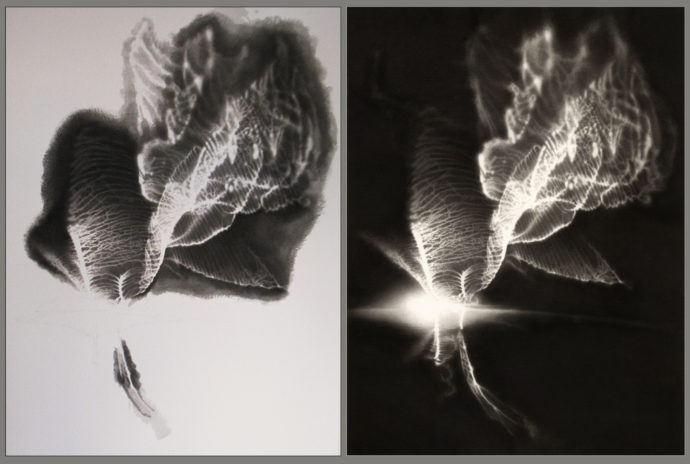
(Right) Donna Diamond, Unanswered Question X, black ink on paper, 2014, 24″ x 18″, with partially completed drawing (left).
Have you done mezzotints previous to the light series?
The light prints are my first mezzotints. I have been working on a small etching press in my home studio and plan to keep going. These first mezzotints are little, but I would like to go much larger.
Why choose the mezzotint medium for your light series?
I was attracted to mezzotint because of the tonal qualities. Mezzotint offers the chance to create whispering light, fragile edges that can dissolve, intense darks, as well as radiant moments. Mezzotint prints also have a mysterious quality that I am drawn to.
As I develop my mezzotints I have been looking at the work of printmakers I admire. I have been spending time with the masterful prints of Fred Mershimer, the elegant work of Mikio Watanabi, Judith Rothschild’s still lifes, and the recent mezzotints of Kirsten Flaherty.
How does your thinking change going from black to white? Is black and white sequence a more intuitive way to discover light in your imagery?
When burnishing an image onto a rocked copper mezzotint plate, the image can look either black or light. The burnished image will appear black if you lean over it wearing a black t-shirt. The burnished copper will reflect the color of your t-shirt. When you look at the burnished image under a light bulb (muted by tracing paper to avoid glare) it will appear light. So I can view an image I’m burnishing as either light or black.
When creating drawings, the tones are glazed in layers. The transition from the white paper to grey tones is done slowly and gradually. This allows me a great deal of control over the values from paper white to ink black.
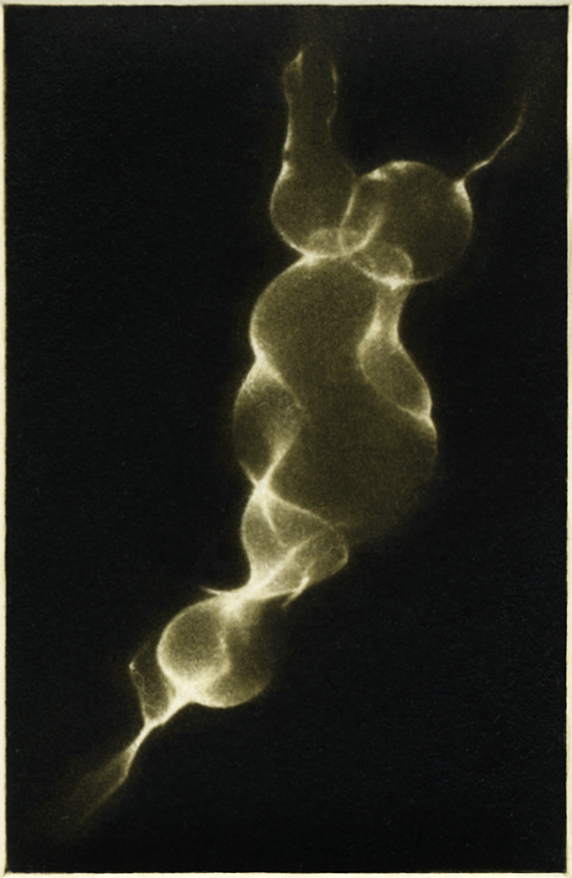
Donna Diamond, Whisper, mezzotint, 2015, plate size: 3” x 2”
Your mezzotints are quite petite. Why? Will They get bigger?
Working on small prints has allowed me to build my experiences with the complicated and challenging mezzotint technique. My suite of little mezzotints describes small and fragile moments of light. There is an intimacy about small prints that appeals to me – they are most often viewed at a close distance by one person at a time.
I am now creating sketches for larger mezzotints. Working with a larger format will allow me to elaborate and expand my thoughts about light and explore more complex ideas.
How does the color of your ink affect your results? Do you have a preference?
I’ve been giving this a lot of thought. I think in dark and light and my first mezzotints were printed with black ink. I began to experiment with tinted ink, a la poupee, and enjoyed the look of warmth in the tones. I do not know how this will evolve or where this will lead me.
How has your light series been received?
I am delighted to share that I just received the 2016 BRIO Award from the Bronx Council on the Arts for my recent light drawings. My earlier light drawings received the BRIO Award in 2013. In that year my drawings were chosen for exhibition by Curate NYC, a citywide festival of art exhibitions and an online showcase.
Additionally, in the past three years, my light drawings have been in gallery exhibits in and around New York City and at The Bronx Museum.
I have recently been editioning my mezzotints and they have been in a number of exhibits in the past few months, both in New York City and in Great Britain.
What’s next in the series?
I am now developing preliminary drawings for a new series of mezzotints. These mezzotints will be larger and more complex. The current preliminary drawings reflect the work that I’ve been doing with light and extend these ideas.
I am also working on preliminary drawings for a new series of linoleum cuts that echo the concepts and tonalities in my light drawings. The linoleum cut that I’m completing now explores a very wide range of values. I’m looking forward to working with artist and collaborative printer Justin Sanz printing the block this summer at the Robert Blackburn Printmaking Workshop.
Back to Justin
Finally two last questions to Juston on Donna’s mezzotints:
As to her tiny mezzotints, did she seek your assistance with these? If so, what were the issues with plate-making or printing of these?
None other than she showing them to me and me being in awe of her abilities. She printed those on her own.
She’s planning much larger mezzotints in her light series. Has she discussed her plans with you? If so, what type of advice have you offered?
I believe she plans to embody the essence of life force and energy. My advice has mostly been encouraging her to follow the path she has chosen and to mention which of her numerous variations of color proofs I prefer.
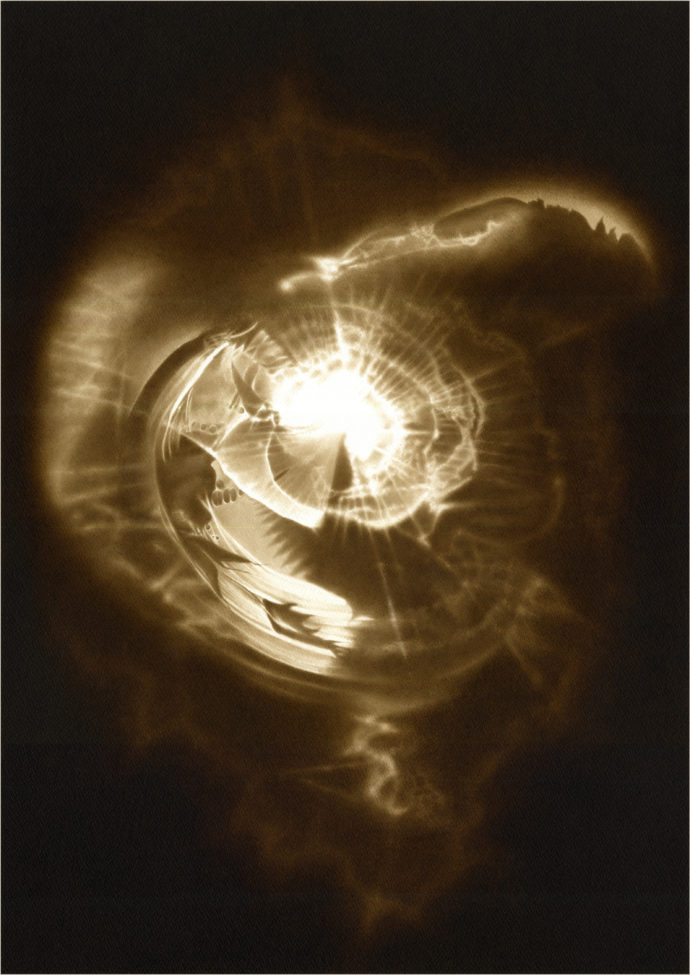
(Above) Donna Diamond, Botanical Light I, 2014, brush and sepia Ink on paper, 28” x 20” (Below) Donna Diamond, Event Horizon, 2015, brush and sepia Ink on paper, 28” x 20”
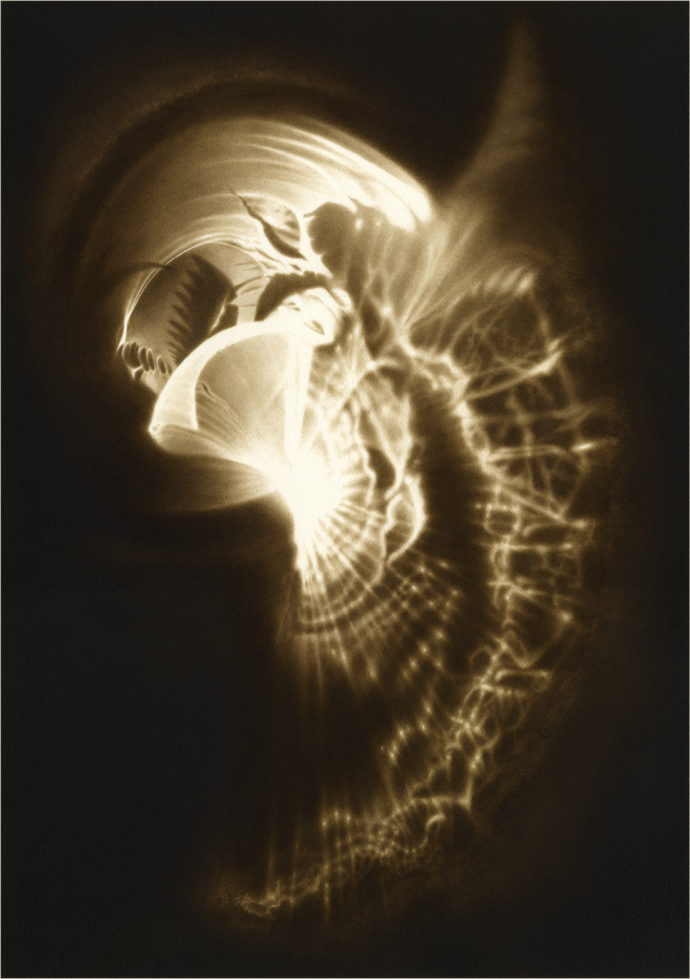
Trackback URL: https://www.scottponemone.com/donna-diamond-imagined-light/trackback/











